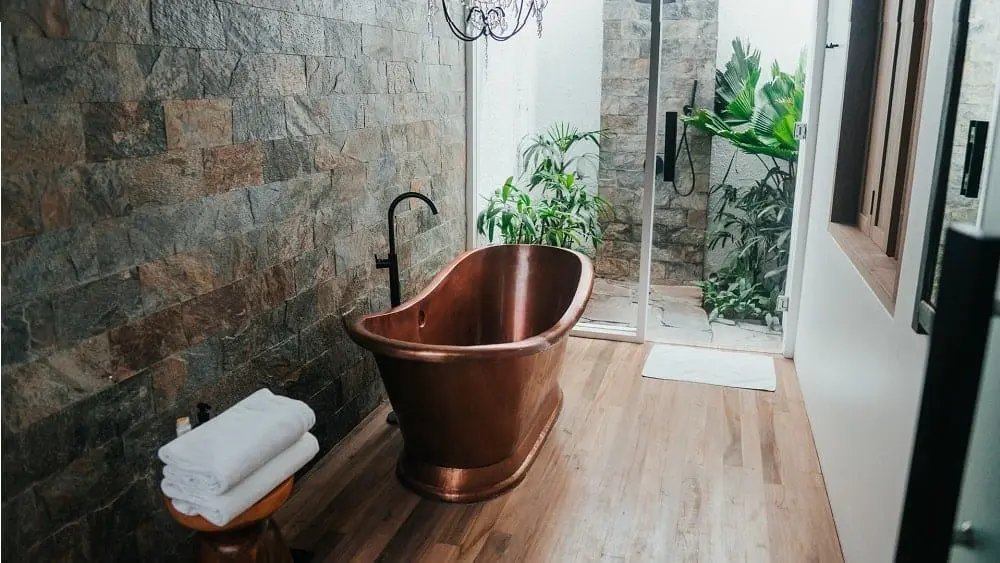
In kitchens, cabinets are going gray. In bathrooms, the tubs seem to want a little distance from the showers. And those infamous “one-percenter” households aren’t ready to give up their dining rooms, no matter how infrequently they use them.
Those are some of the pronouncements from the recent, veritable collision of all things house-y — the International Builders Show (IBS) and the Kitchen & Bath Industry Show (KBIS).
By themselves, the two trade shows are always top showcases of the latest, most drool-worthy items for your house, places where trend-spotters conduct seminars to hold forth on what’s in and what’s out in home styling. This year, in a move that’s the equivalent of catnip for the unabashed home aficionado, the two annual events ran simultaneously and under one roof here in early February.
Stretching literally for acres, only the most undaunted walker could take it all in. Luckily, they didn’t have to, as some recurrent themes wafted through the two shows:
You’ll be seeing gray in your kitchen. Or maybe good old white.
The National Kitchen & Bath Association (NKBA) — sponsor of the Kitchen & Bath Show — released a survey of its members showing that gray-toned cabinetry and accents turned up in significant numbers of new kitchens (and baths) in the past year.
Maria Stapperfenne, president-elect of the association, said it’s the fastest-growing color, although white and off-white cabinets are still a highly popular choice.
For homeowners who fear that they’ll invest big bucks in cabinets that will quickly end up looking dated, the editor in chief of Fine Homebuilding magazine had some fail-safe advice at the show: “White is the one color that’s hard to go wrong with — it seems to always work,” said Brian Pontolilo in a KBIS presentation, “Ideas that Transcend Trends.”
More from the Department of Trends
The NKBA members also said they see momentum in the following areas:
- Traditional cabinet styling is giving way to more contemporary and transitional looks, which are a more clean-lined style, with less ornamentation;
- More demand for energy-conserving appliances and water-conserving plumbing;
- Built-in phone and tablet docking stations in the kitchen;
- More quartz and composite countertops, though granite is not going away;
- Wood flooring in kitchens;
- Dedicated feeding, bathing and grooming areas for pets; and
- It’s not all about what’s in. Fading from consumer preferences, according to the NKBA, are Tuscan styling, whirlpool tubs and black fixtures.
Burn, Burn, Burn
Did you catch Bob Costas carrying on during the Winter Olympics in front of a very long stretch of fireplace? It turned out to be a very credible flat-screen, electronic version of the real thing.
The fireplace’s electric cousins showed up all over the International Builders Show, in ever-longer incarnations. Similar-looking gas and propane-powered models abounded, too.
Green is Growing
Although exhibitors at previous shows (both IBS and KBIS) practically trumpeted their lines of environmentally conscious products, they seemed to turn down the volume this year. While the products were present, the promotion was less heavy-handed.
But maybe they should ratchet it back up: McGraw-Hill Construction, a data firm, reported during IBS that the “green” share of newly constructed homes increased from 2 percent in 2005 to 23 percent in 2013.
The Stuff Dream (Sinks) Are Made Of
Some manufacturers are rolling out new materials that are alternatives to traditional kitchen sink construction. They say these materials promise more in the way of durability, clean-ability and just plain looks. For example:
- Native Trails’ new NativeStone line of sinks is a blend of concrete and jute that the manufacturer says is 40 percent lighter than traditional concrete;
- Laufen debuted SaphirKeramik, right, which adds the mineral corundum to clay to create a new material. The manufacturer claims that its hardness is surpassed only by diamonds and its composition allows sinks to be crafted into previously unattainable configurations, with ultra-thin walls; and
- Numerous manufacturers continue to tinker with the composition of so-called granite sinks (which typically also contain resins) to add other elements, such as quartz.
Separate the Tub From the Shower
Freestanding bathtubs, often in oval shapes, showed up all over the trade show floors. They were usually accompanied by a gracefully sculpted tub filler: stand-alone plumbing that is either wall or floor-mounted.
Cabinets That Move
Perhaps a bow to the universal design movement, which aims to make homes more accessible to elderly, disabled or even very young residents, several cabinet and hinge manufacturers are creating cabinets that pull down, out or up for easier access.
What Richie Rich Wants
Whether you regard it as luxury or excess, the homes of the very wealthy never fail to fascinate. And the design world pays close attention to these consumers’ demands because they tend to trickle down, in some way, to the rest of us.
“The dining rooms may be used only four, five or six times a year, but they still want them,” according to Troy Beasley, co-owner of Beasley & Henley Interior Design in Winter Park, Fla., and Naples, Fla., who specializes in designing for high-end homes. And the owners want to impress their guests — detailing in the dining room is becoming increasingly more extravagant, he said.
Other must-haves among his wealthy clients: open floor plans that make their large homes seem even larger; integrated electronics that allow the homeowners to put TVs everywhere and are designed so that they can easily switch out old tech for new tech; wine cellars; ample decks and patios, outfitted with outdoor kitchens, for entertaining; home offices that act as trophy rooms for executives, complete with celebrity photos, awards, etc.
And Beasley said they really want large kitchens, thus showing — despite what F. Scott Fitzgerald so famously said — that the rich are not really that different from you or me.
 What’s New in Kitchen and Bath Trends: A Visit to the Kohler Design Center
What’s New in Kitchen and Bath Trends: A Visit to the Kohler Design Center